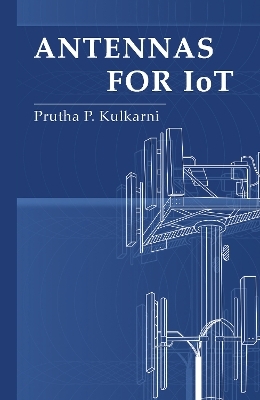
Antennas for IoT
Artech House Publishers (Verlag)
978-1-63081-993-4 (ISBN)
1.0 Introduction
1.1 Antenna application areas in IoT
1.2 Sensors and Antennas
1.3 IoT in Action
1.4 Industrial IoT
1.5 Antenna Parameters
1.6 Antennas used in IoT devices
1.7 The Complexity of the Issue
1.8 Ways antenna is deceiving you
1.9 The Intended Use Is With a Different Electronics Unit
1.10 Variation in Regulations and Directionality
1.11 Additional Issue: The Wrong Plug-In
1.12 Conclusion
2.0 Industry 4.0
2.1 Introduction
2.2 Antenna Technologies in near future
2.3 Antennas suited for Industry 4.0
2.4 Metamaterial based antennas
2.5 Terahertz antennas for IoT
2.6 Fractal Antennas
2.7 Plasma Antennas
2.8 Reconfigurable antennas
2.9 GAP Waveguide
2.10 Details of few new antennas with MIMO capabilities for IoT applications
2.11 Conclusion
3.0 RF and Microwave Aspects of IoT
3.1 Introduction
3.2 Importance of RF and microwave technologies in IoT
3.3 Scope of RF technology in Internet of Things
3.4 RF fundamentals for Internet of Things
3.5 What is RF in IoT?
3.6 Transforming IoT with 5G RF
3.7 5G RF Use Cases in IoT
3.8 RF product recommendations of IoT
3.9 Conclusion
4.0 Basics of Antennas in IoT
4.1 Introduction
4.2 Design of Antennas
4.3 Conclusion
5.0 Antenna Measurement Systems
5.1 Introduction
5.2 Equipment Needed for Antenna Measurements
5.3 Measurement Location Important!
5.4 Ranges in Free Space (Anechoic Chambers)
5.5 Directivity and effectiveness
5.6 Impedance Measurements
5.7 Isolation Measurements
5.8 Scale Model Measurements
5.9 Specific Absorption Rate (SAR)
5.10 SAR measurement
5.11 Conclusion
6.0 Miniaturization technologies
6.1 Introduction
6.2 Practicalities in Miniaturization
6.3 Metamaterials-based Miniaturization
6.4 Wearable Antennas
6.5 Conformal Antennas
6.6 Conclusion
7.0 IoT in Smart Cities
7.1 Introduction
7.2 Why smart cities are necessary?
7.3 How smart cities operate
7.4 Smart city sustainability promotion
7.5 Challenges and concerns with smart cities
7.6 Who and how use data from smart cities?
7.7 The Role of Smartphones in IoT-Enabled Smart Cities
7.8 Practical aspect of smart city and its components in the Internet of Things era
7.9 Future IoT Use Cases
7.10 IoT sensors
7.11 Examples of IoT and Sensor integration in smart city
7.12 Sensor Integration for IoT
7.13 Future Trends for IoT in Smart Cities
7.14 Internet of Things Benefits and Drawbacks for Smart Cities
7.15 IoT and Cloud Computing in Smart Cities
7.16 Conclusion
8.0 IoT in Wireless Communication
8.1 Introduction
8.2 IoT definitions in Wireless
8.3 IoT architecture
8.4 IoT and wireless communication compatibility
8.5 IoT communication and networking protocol development challenges.
8.6 Conclusion
9.0 IoT in Surviellance & Security
9.1 Introduction
9.2 The IoT Security Framework: An Overview
9.3 Threats to IoT Security and Solutions
9.4 IoT Security Guidelines
9.5 Enterprise IoT Security in North America: Current Situation
9.6 Viewing IoT Surveillance's Future
9.7 Future obstacles for IoT video surveillance
9.8 Why are IoT security solutions necessary for today's networks?
9.9 How should we handle data privacy?
9.10 Conclusion
10.0 Reliability and Security Challenges
10.1 Introduction
10.2 Unavoidable encounters
10.3 Standings and situations
10.4 Research Concerns
10.5 Stable Foundations Upon Which to Construct
10.6 Device dependability
10.7 The dependability of networks and communication systems
10.8 Availability and dependability at the application level
10.9 Finding efficient solutions to ensure the dependability of IoT systems
10.10 The significance of protecting connected devices
10.11 The most effective strategies for ensuring the safety of Internet of Things systems
10.12 Conclusion
11.0 Future Scope and Conclusion
11.1 Antennas 3D-printing technology
11.2 The New Trend Is to Get Antennas That Are Much Smaller: Miniaturization
11.3 Future Antenna Technology
11.4 Conclusion
| Erscheinungsdatum | 12.12.2023 |
|---|---|
| Verlagsort | Norwood |
| Sprache | englisch |
| Themenwelt | Technik ► Elektrotechnik / Energietechnik |
| Technik ► Nachrichtentechnik | |
| ISBN-10 | 1-63081-993-X / 163081993X |
| ISBN-13 | 978-1-63081-993-4 / 9781630819934 |
| Zustand | Neuware |
| Haben Sie eine Frage zum Produkt? |
aus dem Bereich


